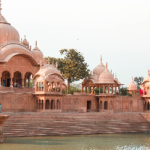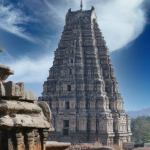Why Taj Mahal is a popular tourist destination for families.

The Taj Mahal is one of the most iconic and renowned monuments in the world, located in Agra, India. It is celebrated as a masterpiece of Mughal architecture and is often considered a symbol of eternal love. Built by Emperor Shah Jahan in memory of his beloved wife Mumtaz Mahal, who died during childbirth, the Taj Mahal is a white marble mausoleum that stands as a testament to the emperor’s undying love and devotion.
Here are some reasons why the Taj Mahal is a popular tourist destination for families:
- Historical Significance: The Taj Mahal is a UNESCO World Heritage Site and is steeped in history. Visiting it provides families with an opportunity to learn about the Mughal Empire, its architecture, and the love story behind this magnificent structure. It’s an educational experience for both parents and children.
- Architectural Marvel: The Taj Mahal’s exquisite architecture, characterized by its symmetrical design, intricate carvings, and stunning use of white marble, is a sight to behold. Children and adults alike can marvel at the craftsmanship and design of this remarkable monument.
- Cultural Experience: A visit to the Taj Mahal also offers families a chance to immerse themselves in Indian culture. They can witness the artistry of local artisans, enjoy traditional Indian cuisine, and participate in cultural activities in and around Agra.
- Photography Opportunities: The Taj Mahal’s stunning beauty makes it a favorite subject for photographers. Families can capture lasting memories of their visit with photos in front of the Taj Mahal’s iconic dome or reflecting in the serene waters of the Yamuna River.
- Beautiful Gardens: The Taj Mahal is surrounded by well-maintained gardens with pathways, fountains, and shaded areas. Families can enjoy a leisurely stroll or have a picnic in these lush surroundings, providing a break from sightseeing.
- Educational Value: Many families find the Taj Mahal’s historical and architectural significance a valuable educational experience for children. It can stimulate curiosity about history, art, and world cultures.
- Romantic Atmosphere: While the Taj Mahal is a symbol of love, its romantic aura can be appreciated by parents and couples, making it an attractive destination for those celebrating anniversaries or special occasions.
- Accessible Location: Agra, where the Taj Mahal is situated, is well-connected by road and train to major cities in India, making it relatively easy for families to include it in their travel itinerary.
- Memorable Family Vacation: Visiting the Taj Mahal can be a memorable family vacation. The awe-inspiring beauty of the monument leaves a lasting impression on both children and adults, fostering a sense of wonder and appreciation for history and art.
In conclusion, the Taj Mahal’s combination of historical significance, architectural beauty, and cultural richness makes it a popular tourist destination for families. It offers a unique blend of education, culture, and beauty that can be enjoyed by visitors of all ages, making it a must-visit attraction for families traveling to India.

Why a tour by car is the best way to see the Taj Mahal with kids.
Touring the Taj Mahal by car can be an excellent choice for families with kids for several compelling reasons:
- Convenience: Traveling by car provides unmatched convenience, especially when you have young children. You can set your own schedule, make stops as needed for restroom breaks or snacks, and accommodate your family’s specific needs without adhering to a rigid tour group itinerary.
- Comfort: Children can get tired easily, especially when exploring a vast and awe-inspiring monument like the Taj Mahal. Having your car nearby allows your kids to rest when needed, ensuring a more enjoyable and comfortable experience.
- Flexible Timing: Kids often have unpredictable schedules and may need naps or breaks at irregular intervals. Traveling by car allows you to adjust your visit’s timing to suit your children’s needs, ensuring they are well-rested and in good spirits during the tour.
- Safety: Having your own vehicle provides a controlled and familiar environment for your children. You can ensure their safety and well-being, including proper car seats and childproofing, which might not be readily available in tour buses or taxis.
- Storage: Car tours offer ample storage space for strollers, diaper bags, snacks, and other essentials that families with kids often need. You can carry everything you need without worrying about luggage restrictions or limited storage on public transportation.
- Privacy: Traveling by car provides a degree of privacy that can be essential for families. You can have conversations, manage your children’s needs, and enjoy your family time without the presence of other tourists.
- Local Exploration: With your own car, you have the flexibility to explore the local area around the Taj Mahal at your own pace. You can visit nearby attractions, parks, or markets, enhancing your family’s overall experience.
- Temperature Control: The weather in Agra can be quite extreme, with scorching summers and chilly winters. Having a car allows you to control the temperature inside the vehicle, ensuring your children’s comfort in all weather conditions.
- Customized Experience: When you tour the Taj Mahal by car, you can customize your visit based on your family’s interests. If your kids are interested in a specific aspect of the monument’s history or architecture, you can focus on that without being constrained by a group tour’s agenda.
- Avoiding Crowds: The Taj Mahal is a major tourist attraction and can get crowded, especially during peak tourist seasons. With a car, you can plan your visit during less crowded times, ensuring a more peaceful and enjoyable experience for your family.
While touring the Taj Mahal by car offers numerous advantages for families with kids, it’s essential to plan ahead, including parking arrangements and any necessary permits, to ensure a smooth and enjoyable visit. Additionally, hiring a local guide who can provide insights into the monument’s history and significance can enhance your family’s educational experience while exploring this iconic site.

Plan for a trip to Taj Mahal from New Delhi
A trip to the Taj Mahal from New Delhi is a popular and relatively straightforward journey. Here’s a step-by-step plan to help you make the most of your visit:
Day 1: Depart from New Delhi to Agra
- Morning: Start your day early to beat the traffic. Have a hearty breakfast in New Delhi, and ensure your car is fueled up for the journey.
- Travel: The distance between New Delhi and Agra is approximately 200 kilometers (124 miles). You can take the Yamuna Expressway, which is a well-maintained toll road that typically takes around 3-4 hours to reach Agra by car.
- En Route: Consider stopping at the Sikandra Fort, the tomb of Emperor Akbar, on your way to Agra. It’s a fascinating historical site and adds value to your trip.
- Lunch: Arrive in Agra by early afternoon. Check-in to your chosen accommodation. There are various hotel options in Agra to suit different budgets.
- Taj Mahal Visit: After settling in, head to the Taj Mahal. It’s best to visit in the late afternoon or early evening to avoid the midday heat and crowds. The changing light conditions during sunset also add to the monument’s beauty. Purchase your tickets in advance online to save time at the entrance.
- Dinner: After visiting the Taj Mahal, enjoy a delicious dinner at a local restaurant in Agra. Try some authentic Mughlai cuisine.
Day 2: Explore Agra
- Sunrise at Mehtab Bagh: If you’re interested in capturing the Taj Mahal during sunrise, consider visiting the Mehtab Bagh (Moonlight Garden) across the river from the Taj. It offers a stunning view of the monument at dawn.
- Breakfast: Return to your hotel for breakfast.
- Agra Fort: Visit the Agra Fort, a UNESCO World Heritage Site, which is another architectural marvel in Agra. It’s located close to the Taj Mahal and offers a glimpse into India’s history.
- Lunch: Have lunch at a local restaurant or at your hotel.
- Local Markets: Spend your afternoon exploring the local markets in Agra, such as Sadar Bazaar, where you can shop for souvenirs, handicrafts, and local specialties.
- Itimad-ud-Daulah (Baby Taj): If time allows, visit Itimad-ud-Daulah, often referred to as the “Baby Taj.” It’s a smaller, but equally stunning, marble tomb.
- Return to Delhi: In the late afternoon or early evening, start your journey back to New Delhi. Plan your departure time based on your preferences and traffic conditions.
- Dinner: You can have dinner either in Agra or on the way back to New Delhi, depending on your timing.
Additional Tips:
- Ensure you have all necessary permits and tickets in advance to avoid delays.
- Consider hiring a local guide to enhance your experience and learn more about the history and significance of the Taj Mahal and other sites.
- Pack essentials like sunscreen, hats, comfortable walking shoes, and a camera.
- Check for any COVID-19 related travel restrictions or guidelines before your trip.
- Be prepared for varying weather conditions, especially if you plan to visit during summer or winter months.
This two-day trip will allow you to explore the Taj Mahal and other attractions in Agra at a relaxed pace, making it a memorable experience for your visit from New Delhi.
When to go: The best time to visit the Taj Mahal is during the spring or fall, when the weather is mild.
Visiting the Taj Mahal during the spring or fall is indeed a popular choice for many travelers due to the mild and pleasant weather conditions during these seasons. Here’s why spring and fall are considered the best times to visit the Taj Mahal:
Spring (March to May):
- Mild Temperature: Spring in Agra brings comfortable daytime temperatures ranging from 20°C to 30°C (68°F to 86°F). It’s neither too hot nor too cold, making it ideal for exploring the monument and its surroundings.
- Blooming Gardens: The gardens around the Taj Mahal are at their most beautiful during spring when flowers are in full bloom. The lush greenery and colorful flora enhance the overall ambiance and aesthetic appeal of the site.
- Clear Skies: Spring typically offers clear skies with minimal rainfall, ensuring good visibility for viewing and photographing the Taj Mahal.
Fall (October to November):
- Mild and Pleasant Weather: Similar to spring, fall in Agra provides mild and pleasant temperatures ranging from 15°C to 30°C (59°F to 86°F). The weather is comfortable for outdoor activities.
- Lower Crowds: While not as crowded as winter, the fall season tends to have fewer tourists compared to the peak winter months, which can lead to a more peaceful and enjoyable visit.
- Festivals: You may have the opportunity to witness and participate in local festivals and cultural events, adding an extra layer of cultural richness to your visit.
Keep in mind that Agra experiences extreme weather conditions during the summer and winter months:
- Summer (June to August): Agra can get extremely hot during the summer months, with temperatures often exceeding 40°C (104°F). The scorching heat can make outdoor activities uncomfortable.
- Winter (December to February): While winters in Agra are cool and pleasant during the day, the nights can be quite cold, with temperatures dropping to near freezing. Winter is the peak tourist season, so the Taj Mahal can get very crowded.
In summary, visiting the Taj Mahal in spring (March to May) or fall (October to November) offers the best balance of comfortable weather, beautiful surroundings, and fewer crowds. However, the monument is open year-round, so you can plan your visit based on your personal preferences and schedule. Regardless of when you visit, make sure to check the local weather forecast and any travel advisories before your trip.
How long to stay: You will need at least half a day to see the Taj Mahal, but a full day is better if you want to explore other nearby attractions.
The duration of your stay in Agra and at the Taj Mahal can vary depending on your interests and travel itinerary. Here are some considerations to help you decide how long to stay:
1. Half a Day (Approximately 4-5 Hours):
- If you’re on a tight schedule or have limited time, you can visit the Taj Mahal in half a day.
- This duration allows you to explore the main mausoleum, admire the Taj Mahal’s exterior and interior, and take in the iconic views.
- It’s a suitable option for those on a quick day trip from nearby cities like Delhi, Mathura, or Jaipur.
2. Full Day (Approximately 8-10 Hours):
- A full day is ideal if you want to thoroughly explore not only the Taj Mahal but also other nearby attractions in Agra.
- With a full day, you can visit the Agra Fort, explore the markets, sample local cuisine, and enjoy a more leisurely experience.
- This option is recommended if you’re interested in a more comprehensive tour of Agra’s historical and cultural sites.
3. Two Days or More:
- If you have more time and a deep interest in history and architecture, consider spending two or more days in Agra.
- This allows you to visit additional attractions like Fatehpur Sikri, Itimad-ud-Daulah (Baby Taj), and Mehtab Bagh for different perspectives on Mughal architecture and history.
- You can also take your time to immerse yourself in the local culture, cuisine, and markets.
Remember that the Taj Mahal is open from sunrise to sunset every day except Fridays when it is closed for prayers. Plan your visit accordingly to make the most of your time. Additionally, hiring a local guide can enhance your experience and provide valuable insights into the history and significance of the Taj Mahal and other nearby sites.
Ultimately, the duration of your stay should align with your interests, available time, and how much you wish to explore beyond the Taj Mahal. A full day allows for a well-rounded experience, but you can adjust your itinerary to fit your preferences and schedule.

Where to stay: There are many hotels and guesthouses in Agra, but it is best to stay close to the Taj Mahal so you can get there early in the morning to avoid the crowds.
Staying close to the Taj Mahal is indeed a popular choice for many visitors to Agra, as it offers several advantages, especially for those who want to experience the monument during the early morning hours when crowds are thinner and the lighting is excellent for photography. Here are some areas and accommodation options to consider when choosing where to stay in Agra:
1. Taj Ganj:
- Taj Ganj is the area nearest to the Taj Mahal and offers a range of hotels and guesthouses catering to various budgets.
- Staying in Taj Ganj allows you to walk to the Taj Mahal, making it convenient to visit early in the morning.
- Some hotels in this area even offer views of the Taj Mahal from their rooms or rooftops.
2. Fatehabad Road:
- Fatehabad Road is another popular area for tourists, located a short distance from the Taj Mahal.
- This area features a mix of hotels, restaurants, and shops, making it convenient for travelers.
- While it’s not as close as Taj Ganj, it’s still within a manageable distance from the Taj Mahal.
3. Sanjay Place:
- Sanjay Place is a commercial and shopping district in Agra, which is a bit farther from the Taj Mahal but still offers a variety of hotel options.
- Staying in Sanjay Place might be preferable if you prefer a more bustling city atmosphere and have other plans in Agra beyond visiting the Taj Mahal.
4. Agra Cantonment:
- Agra Cantonment is the area around the Agra Railway Station and offers a wide range of hotels, including some upscale options.
- While it’s not as close to the Taj Mahal as Taj Ganj or Fatehabad Road, it’s a convenient location if you’re arriving in Agra by train.
When choosing where to stay, consider your budget, preferences, and itinerary. If visiting the Taj Mahal early in the morning is a top priority, Taj Ganj or Fatehabad Road are excellent choices due to their proximity to the monument. However, keep in mind that these areas may have higher demand, so it’s advisable to book your accommodation in advance, especially during the peak tourist season.
Ultimately, the best place to stay in Agra depends on your individual preferences and priorities for your visit to this historic city.
What to pack: Be sure to pack comfortable shoes, sunscreen, and a hat. You may also want to bring a water bottle and snacks.
Packing for a visit to the Taj Mahal and Agra requires some careful consideration, as you’ll want to ensure you have everything you need for a comfortable and enjoyable experience. Here’s a list of essential items to pack:
1. Comfortable Shoes: Walking is an integral part of exploring the Taj Mahal and its surrounding areas. Wear comfortable and supportive walking shoes to ensure you can navigate the site comfortably. Avoid open-toed shoes or sandals with inadequate support.
2. Sunscreen: Agra can have intense sun, especially during the summer months. Protect your skin from sunburn by packing sunscreen with a high SPF rating. Reapply it as needed throughout the day.
3. Hat and Sunglasses: A wide-brimmed hat and sunglasses are essential for shielding your face and eyes from the sun. They also provide some relief during hot and sunny days.
4. Water Bottle: Staying hydrated is crucial, especially in warm weather. Bring a reusable water bottle and refill it as needed. There are water stations available in and around the Taj Mahal.
5. Snacks: Pack some light snacks to keep your energy up while exploring. Granola bars, nuts, or fruits make for convenient and portable options.
6. Camera and Smartphone: Capture the beauty of the Taj Mahal by bringing a camera or smartphone with a good camera. Don’t forget extra memory cards or batteries, if needed.
7. Travel Documents: Ensure you have all necessary travel documents, including identification, tickets, and hotel reservations, in a secure and easily accessible place.
8. Cash and Payment Methods: Carry some cash in the local currency (Indian Rupees) for small purchases and transportation. Additionally, it’s wise to have a credit/debit card or mobile payment apps for larger expenses.
9. Local Map or Guidebook: A local map or guidebook can be handy for navigating the city and locating other attractions beyond the Taj Mahal.
10. Backpack or Daypack: A lightweight backpack or daypack is useful for carrying your essentials while exploring. It’s a practical way to store your belongings without being burdensome.
11. Weather-Appropriate Clothing: Dress appropriately for the weather. In hot weather, wear lightweight, breathable clothing, while in cooler months, bring layers for comfort.
12. Travel Adapter: If you’re visiting from a different country, bring a travel adapter to charge your electronic devices.
13. Insect Repellent: Depending on the season, you may want to pack insect repellent to protect against mosquitoes and other insects, especially if you plan to explore areas outside the Taj Mahal.
14. Hand Sanitizer and Tissues: Carry hand sanitizer and tissues for personal hygiene, especially when using public restrooms.
By packing these essentials, you’ll be well-prepared for a comfortable and enjoyable visit to the Taj Mahal and the city of Agra. Remember to adjust your packing list based on the specific season and weather conditions during your trip.
The Tour
The tour plan you’ve outlined for visiting the Taj Mahal is excellent, especially for families with kids. Here’s a more detailed breakdown of the suggested itinerary and additional tips for a family-friendly visit:
Morning:
- Early Start: Begin your day very early to ensure you arrive at the Taj Mahal before the crowds. Sunrise is a particularly beautiful time to visit.
- Admire the Architecture: Take your time exploring the Taj Mahal complex. Encourage your kids to appreciate the intricate architecture, the beautiful gardens, and the serene atmosphere.
- Engage with a Guide: Hiring a knowledgeable guide is highly recommended. Choose a guide who is experienced in working with children and can make the history and significance of the Taj Mahal engaging and understandable for kids.
Mid-Morning:
- Educational Moments: As you explore, ask your guide to share interesting stories and facts about the Taj Mahal’s history. Engage your kids with questions to make the learning experience interactive and fun.
- Photo Opportunities: Capture memorable family photos with the Taj Mahal as a backdrop. The changing light conditions throughout the morning offer excellent photography opportunities.
Late Morning:
- Optional Visit to Other Attractions: If your family is up for more exploration and has the time, consider visiting nearby attractions like the Agra Fort or Fatehpur Sikri. These sites offer different aspects of Mughal history and architecture.
Tips for Families:
- Snacks and Drinks: Bring a small backpack with snacks and drinks for your kids. Exploring the Taj Mahal can be tiring, and having refreshments on hand will keep your family energized.
- Rest and Breaks: Allow plenty of time for rest and breaks. Kids may need breaks to sit down, hydrate, or have a snack. The Taj Mahal gardens are a great place for a short break.
- Sun Protection: Be prepared for the heat and sun. Apply sunscreen to your children’s skin, and make sure they wear hats and sunglasses for protection.
- Entertainment: Keep your kids entertained during breaks with games, coloring books, or other activities. This can help prevent boredom during downtime.
- Child-Friendly Guide: As mentioned earlier, choose a guide who knows how to engage with children. They can make the tour more interesting and enjoyable for the whole family.
- Flexible Schedule: Be flexible with your schedule and adapt it to your children’s needs. If they show signs of fatigue or if the weather is too hot, it’s okay to cut the tour short.
By following this itinerary and these tips, you can make your family’s visit to the Taj Mahal a memorable and educational experience while ensuring the comfort and well-being of your children. The Taj Mahal’s beauty and historical significance are sure to leave a lasting impression on your family.
Conclusion:
In conclusion, the Taj Mahal is a magnificent and awe-inspiring destination that can captivate and educate your kids about history, architecture, and culture. Choosing a tour by car offers convenience and flexibility, ensuring a comfortable and enjoyable experience for the entire family. With careful planning, snacks, hydration, and engaging activities, your visit to the Taj Mahal can be a memorable and enriching adventure that leaves a lasting impression on both parents and children alike. Enjoy your tour of this iconic wonder with your kids!
Q: Is car allowed in Taj Mahal?
A: No, cars are not allowed within the immediate vicinity of the Taj Mahal. To reach the Taj Mahal, visitors typically need to park their cars in designated parking areas and then use authorized transportation options like battery-operated shuttle buses, horse-drawn carriages, or cycle rickshaws to get closer to the monument. The Taj Mahal complex itself is a vehicle-free zone to preserve its environment.
Q: How much time is sufficient for Taj Mahal visit?
A: The amount of time sufficient for a visit to the Taj Mahal can vary depending on your interests. Generally, most visitors spend around 2 to 3 hours exploring the Taj Mahal, which includes admiring the monument, taking photographs, and learning about its history from a guide. However, if you want to explore the surrounding gardens, visit nearby attractions like the Agra Fort or Fatehpur Sikri, or simply take your time to soak in the beauty of the Taj, you might need a half-day to a full day or more.
Q: How many rupees is a Taj Mahal ticket?
A: The ticket prices for the Taj Mahal can change over time due to government policies and inflation. It’s essential to check the latest ticket prices and entry regulations on the official website or contact the relevant authorities or ticket booths before your visit. As of my last knowledge update in September 2021, the Taj Mahal entrance fee for foreign tourists was higher than for Indian citizens, and there were additional fees for entry to specific areas within the complex, like the main mausoleum.
Q: What is the best way to visit Taj Mahal?
A: The best way to visit the Taj Mahal can depend on your preferences and circumstances. Here are some common approaches:
- Hiring a knowledgeable guide can greatly enhance your experience by providing historical context and interesting anecdotes about the Taj Mahal. Guides can cater to the interests of both adults and children.
- Arriving early in the morning, preferably at sunrise, allows you to enjoy the Taj Mahal with fewer crowds and favorable lighting conditions for photography.
- Weekdays tend to be less crowded than weekends, so if you have flexibility in your schedule, consider planning your visit accordingly.
- Avoiding the peak tourist season (typically during the winter months) can result in a more tranquil experience.
- Consider eco-friendly modes of transportation within the Taj Mahal complex, such as walking or using non-motorized options like bicycles or cycle rickshaws, to minimize your environmental impact.
Please note that entry regulations, ticket prices, and visitor guidelines may change, so it’s crucial to verify the most up-to-date information before your visit to ensure a smooth and enjoyable experience at the Taj Mahal.




